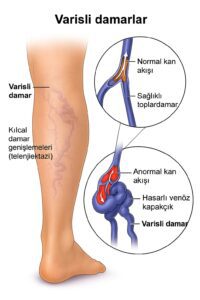
What are varicose veins? Varicose veins are a type of vascular disease that occurs when veins become enlarged, twisted, and overfilled with blood. They are most commonly seen in the legs, particularly in the calves and behind the knees. Veins are blood vessels that return deoxygenated blood to the heart, and the valves within them help ensure that blood flows upward against gravity.
Over time, weakening of these valves or vein walls causes blood to flow backward. This leads to increased pressure inside the vein and expansion of the vein wall. The expanded veins become visible from the skin surface and can appear purple-red and green in color and have a twisted structure.
What Causes Varicose Veins?
There are many risk factors that facilitate the formation of varicose veins:
- Advanced age: As people age, vein elasticity decreases and valve function may deteriorate.
- Female gender: Hormonal factors, particularly estrogen, increase the risk of developing varicose veins in women.
- Pregnancy: Increased blood volume and hormonal changes during pregnancy can weaken vein walls and increase pressure on leg veins.
- Genetic predisposition: Varicose veins are more common in individuals with a family history of the condition.
- Obesity: Excess body weight increases pressure on the leg veins, placing extra strain on the valves.
- Standing for long periods: Prolonged standing without movement can cause blood to pool in the legs, increasing pressure in the veins.
- Previous Deep Vein Thrombosis (DVT): Past episodes of DVT may have damaged the vein valves, impairing proper blood flow and increasing the risk of varicose veins.
What are the Symptoms of Varicose Veins?
The symptoms of varicose veins can vary depending on the stage of the disease:
- Pain and heaviness in the legs
- Swelling (edema), especially in the evening hours
- Itching, burning sensation
- Night cramps
- Visible purple-red and green superficial veins
- Ulcer (open wound) development in advanced stages
In the early stage of varicose veins, only capillary vein visibility (spider veins) may be seen, while thicker veins become visible in later stages. In the most advanced stage, open wounds (venous ulcers) may appear around the ankle.
How are Varicose Veins Diagnosed?
Diagnosis is usually made through physical examination. The doctor listens to the patient’s complaints and observes the vascular structure in the legs.
For definitive diagnosis and treatment planning, the following test is used:
- Doppler Ultrasonography: This imaging technique evaluates blood flow within the veins and assesses the function of the valves. It helps determine which veins are affected and the severity of the condition.
How are Varicose Veins Treated?
The treatment approach varies depending on the stage of the disease, the level of patient complaints, and cosmetic expectations.
1. Lifestyle Changes
- Avoid standing for long periods.
- Lose excess weight.
- Exercise regularly (walking, swimming).
- Avoid tight clothing and high-heeled shoes.
2. Compression Stockings (Elastic Compression)
Compression stockings facilitate the upward flow of blood in the veins by applying external pressure. They reduce symptoms and slow the progression of the disease, especially in individuals who will be standing for long periods during the day.
3. Sclerotherapy (Injection Treatment)
Preferred especially for capillary varicose veins. A medication is injected into the vein to close it. The appearance disappears over time. It is generally applied for aesthetic purposes and may require multiple sessions.
4. Laser and Radiofrequency Treatment
Applied to thick veins. The vein interior is destroyed and dried up with heat energy. A catheter is inserted into the vein, and the vein wall is destroyed with laser or radiofrequency energy.
Advantages:
- No hospital stay required
- Short recovery period
- Can be performed as an outpatient procedure
- Less pain and bruising
5. Surgical Method (Stripping)
Applied for very wide and twisted veins where laser or radiofrequency is insufficient. The enlarged vein is surgically removed. This procedure is now rarely performed.
Are Varicose Veins a Serious Disease?
Varicose veins do not directly threaten life, but:
- Can seriously reduce quality of life
- Can cause aesthetic concerns
- Can lead to complications such as ulcers and thrombophlebitis in advanced stages
Therefore, when symptoms start, especially when visible veins are noticed on the feet, a cardiovascular surgeon should be consulted.
Varicose veins are a common vascular disease that can progress if not treated in time. With early diagnosis and appropriate treatment, both symptoms can be controlled and complications can be prevented. Successful results are obtained with lifestyle adjustments, medical treatments, and interventional procedures.
